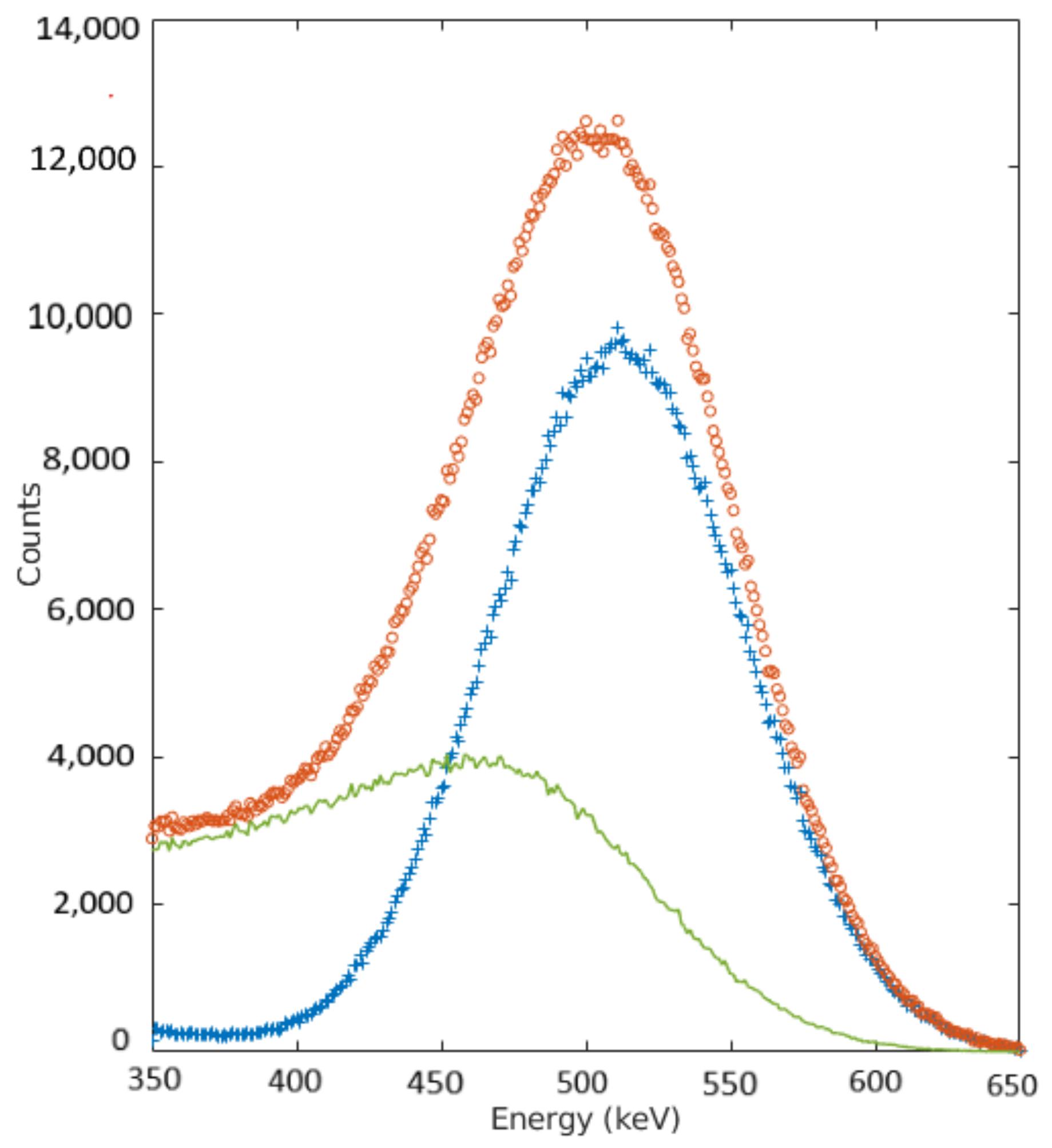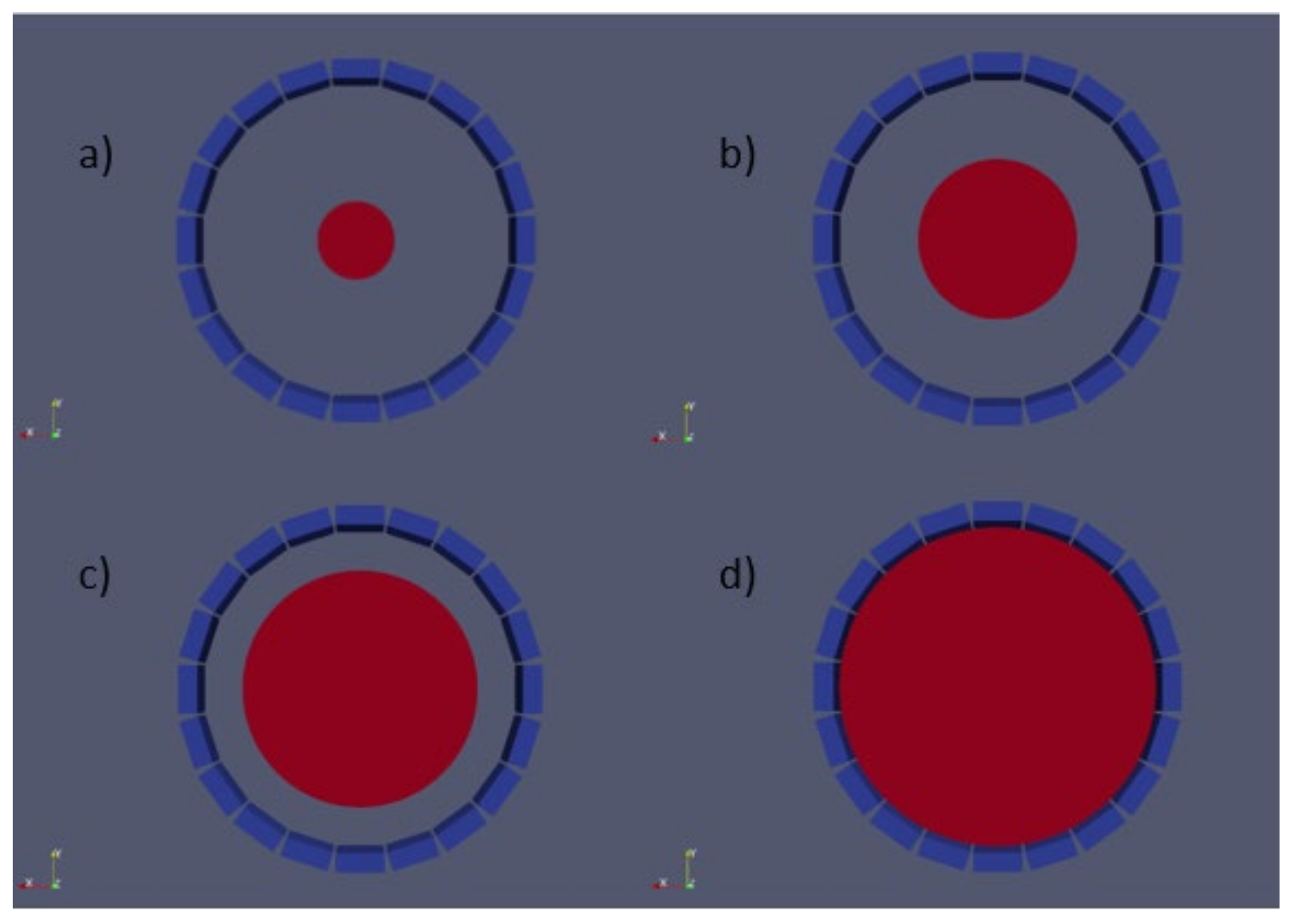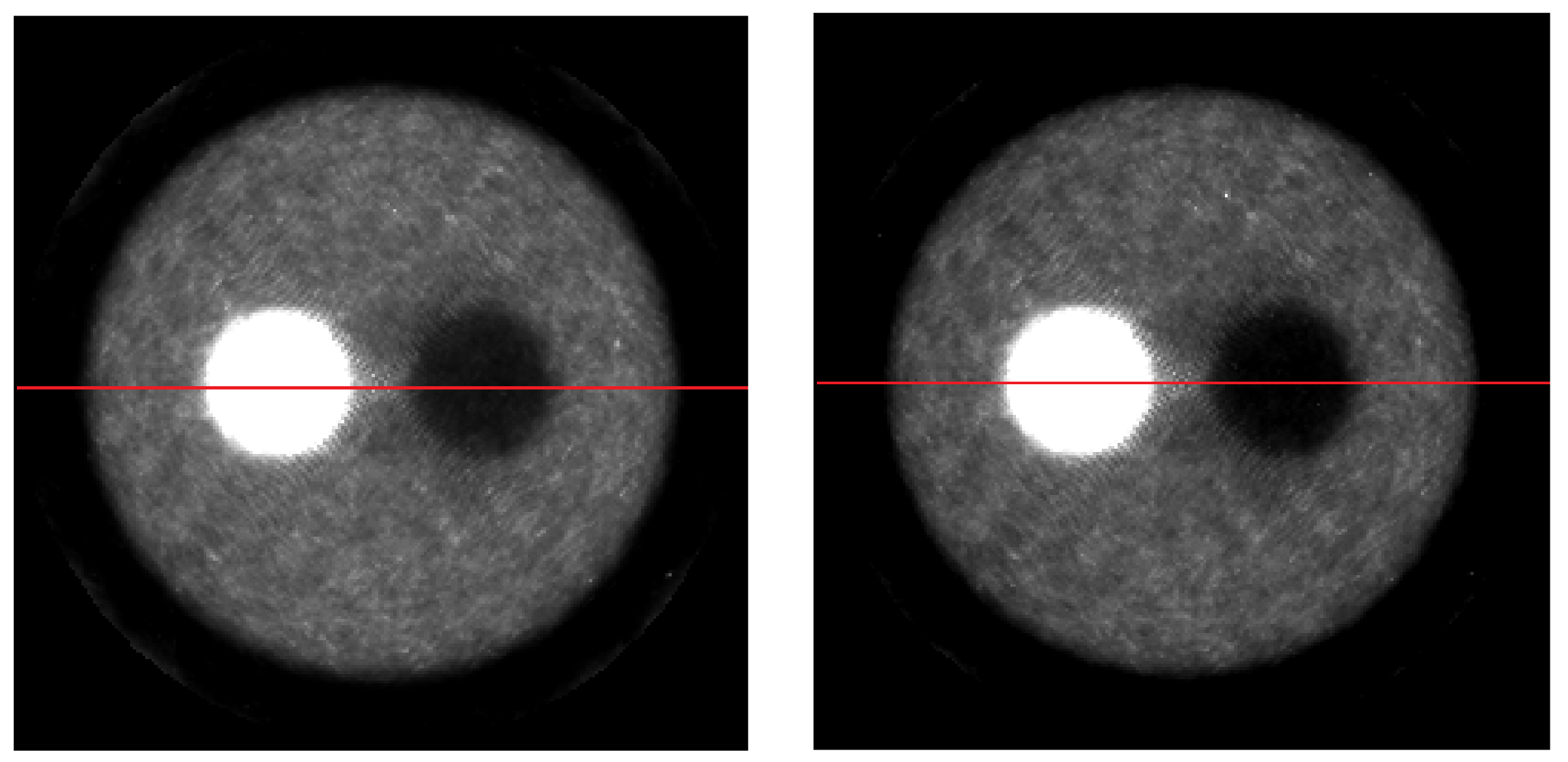Fast Energy Dependent Scatter Correction for List-Mode PET Data
Abstract
:1. Introduction
2. Materials and Methods
2.1. Scanner Design and Simulation Setup
2.2. Choice of Energy Windows
2.2.1. Double Energy Window Method
2.2.2. Triple Energy Window Method
2.3. Scatter Algorithm
2.3.1. Simulation of the PET System and Calculation of the Scatter Coefficients
2.3.2. Storing and Processing Events from the List-Mode Input File
2.3.3. Scatter Fraction Estimation per LOR
2.3.4. Suppression of the Scatter Counts and Validation
3. Validation and Results
4. Discussion
Author Contributions
Funding
Institutional Review Board Statement
Informed Consent Statement
Data Availability Statement
Acknowledgments
Conflicts of Interest
References
- Zaidi, H. Comparative evaluation of scatter correction techniques in 3D positron emission tomography. Eur. J. Nucl. Med. Mol. Imaging 2000, 27, 1813–1826. [Google Scholar] [CrossRef] [Green Version]
- Zaidi, H.; Montandon, M.-L. Scatter Compensation Techniques in PET. PET Clin. 2007, 2, 219–234. [Google Scholar] [CrossRef]
- Polycarpou, I.; Thielemans, K.; Manjeshwar, R.; Aguiar, P.; Marsden, P.K.; Tsoumpas, C. Comparative evaluation of scatter correction in 3D PET using different scatter-level approximations. Ann. Nucl. Med. 2011, 25, 643–649. [Google Scholar] [CrossRef]
- Watson, C.; Newport, D.; Casey, M.; Dekemp, R.; Beanlands, R.; Schmand, M. Evaluation of simulation-based scatter correction for 3-D PET cardiac imaging. IEEE Trans. Nucl. Sci. 1997, 44, 90–97. [Google Scholar] [CrossRef]
- Conti, M.; Hong, I.; Michel, C. Reconstruction of scattered and unscattered PET coincidences using TOF and energy information. Phys. Med. Biol. 2012, 57, N307–N317. [Google Scholar] [CrossRef]
- Berker, Y.; Kiessling, F.; Schulz, V. Scattered PET data for attenuation-map reconstruction in PET/MRI. Med. Phys. 2014, 41, 102502. [Google Scholar] [CrossRef]
- Berker, Y.; Karp, J.S.; Schulz, V. Numerical Algorithms for Scatter-to-Attenuation Reconstruction in PET: Empirical Comparison of Convergence, Acceleration, and the Effect of Subsets. IEEE Trans. Radiat. Plasma Med. Sci. 2017, 5, 426–434. [Google Scholar] [CrossRef]
- Brusaferri, L.; Bousse, A.; Tsai, Y.-J.; Atkinson, D.; Ourselin, S.; Hutton, B.F.; Arridge, S.; Thielemans, K. Maximum-likelihood estimation of emission and attenuation images in 3D PET from multiple energy window measurements. In Proceedings of the 2018 IEEE Nuclear Science Symposium and Medical Imaging Conference Proceedings (NSS/MIC), Sydney, Australia, 10–17 November 2018; pp. 1–3. [Google Scholar] [CrossRef]
- Brusaferri, L.; Bousse, A.; Efthimiou, N.; Emond, E.; Atkinson, D.; Ourselin, S.; Hutton, B.F.; Arridge, S.; Thielemans, K. Potential benefits of incorporating energy information when estimating attenuation from PET data. In Proceedings of the 2017 IEEE Nuclear Science Symposium and Medical Imaging Conference (NSS/MIC), Atlanta, GA, USA, 21–28 October 2017; pp. 1–4. [Google Scholar] [CrossRef]
- Zhang, G.; Sun, H.; Pistorius, S. Feasibility of Scatter B Based Electron Density Reconstruction for Attenuation Correcttion in Positron Emission Tomography. In Proceedings of the 2014 IEEE Nuclear Science Symposium and Medical Imaging Conference (NSS/MIC), Seattle, WA, USA, 8–15 November 2014; Volume 1, pp. 3–5. [Google Scholar]
- Berker, Y.; Schulz, V.; Karp, J.S. Algorithms for joint activity–attenuation estimation from positron emission tomography scatter. EJNMMI Phys. 2019, 6, 1–30. [Google Scholar] [CrossRef] [Green Version]
- Levin, C.; Dahlbom, M.; Hoffman, E. A Monte Carlo correction for the effect of Compton scattering in 3-D PET brain imaging. IEEE Trans. Nucl. Sci. 1995, 42, 1181–1185. [Google Scholar] [CrossRef] [Green Version]
- Qian, H.; Rui, X.; Ahn, S. Deep Learning Models for PET Scatter Estimations. In Proceedings of the 2017 IEEE Nuclear Science Symposium and Medical Imaging Conference (NSS/MIC), Atlanta, GA, USA, 21–28 October 2017; pp. 1–5. [Google Scholar] [CrossRef]
- Zhu, J.; Xu, W.; Niu, M.; Xi, D.; Zhang, X.; Xie, Q. Investigation of timing resolution and energy resolution for SiPM/PET detectors using the silicon flexible optical material. In Proceedings of the 2009 IEEE Nuclear Science Symposium Conference Record (NSS/MIC), Orlando, FL, USA, 25–31 October 2009; pp. 1588–1591. [Google Scholar] [CrossRef] [Green Version]
- Grootoonk, S.; Spinks, T.J.; Sashin, D.; Spyrou, N.M.; Jones, T. Correction for scatter in 3D brain PET using a dual energy window method. Phys. Med. Biol. 1996, 41, 2757. [Google Scholar] [CrossRef]
- Bong, J.-K.; Son, H.-K.; Lee, J.D.; Kim, H.-J. Improved scatter correction for SPECT images: A Monte Carlo study. IEEE Trans. Nucl. Sci. 2005, 52, 1263–1270. [Google Scholar] [CrossRef] [Green Version]
- Zaidi, H.; Koral, K.F. Scatter modelling and compensation in emission tomography. Eur. J. Nucl. Med. Mol. Imaging 2004, 31, 761–782. [Google Scholar] [CrossRef] [Green Version]
- Lowdon, M.; Martin, P.G.; Hubbard, M.; Taggart, M.; Connor, D.T.; Verbelen, Y.; Sellin, P.; Scott, T.B. Evaluation of Scintillator Detection Materials for Application within Airborne Environmental Radiation Monitoring. Sensors 2019, 19, 3828. [Google Scholar] [CrossRef] [Green Version]
- Shimazoe, K.; Yoshino, M.; Ohshima, Y.; Uenomachi, M.; Oogane, K.; Orita, T.; Takahashi, H.; Kamada, K.; Yoshikawa, A.; Takahashi, M. Development of simultaneous PET and Compton imaging using GAGG-SiPM based pixel detectors. Nucl. Instrum. Methods Phys. Res. Sect. A Accel. Spectrom. Detect. Assoc. Equip. 2020, 954, 161499. [Google Scholar] [CrossRef]
- Cherry, S.R. Multimodality Imaging: Beyond PET/CT and SPECT/CT. Semin. Nucl. Med. 2009, 39, 348–353. [Google Scholar] [CrossRef] [Green Version]
- Gonzalez, A.J.; Berr, S.S.; Cañizares, G.; Gonzalez-Montoro, A.; Orero, A.; Correcher, C.; Rezaei, A.; Nuyts, J.; Sanchez, F.; Majewski, S.; et al. Feasibility Study of a Small Animal PET Insert Based on a Single LYSO Monolithic Tube. Front. Med. 2018, 5, 328. [Google Scholar] [CrossRef] [Green Version]
- González, A.J.; Majewski, S.; Barberá, J.; Conde, P.; Correcher, C.; Hernández, L.; Benlloch, J.M. Performance study of a wide-area SiPM array, ASICs controlled. IEEE Trans. Nucl. Sci. 2015, 62, 19–26. [Google Scholar] [CrossRef]
- Adam, L.E.; Karp, J.S.; Freifelder, R. Energy-based scatter correction for 3-D PET scanners using NaI(T1) detectors [In Process Citation]. IEEE Trans. Med. Imaging 2000, 19, 513–521. [Google Scholar] [CrossRef]
- Moliner, L.; Correcher, C.; Gonzalez, A.; Conde, P.; Hernández, L.; Orero, A.; Rodriguez-Alvarez, M.J.; Sánchez, F.; Soriano, A.; Vidal, L.; et al. Implementation and analysis of list mode algorithm using tubes of response on a dedicated brain and breast PET. Nucl. Instrum. Methods Phys. Res. Sect. A Accel. Spectrom. Detect. Assoc. Equip. 2012, 702, 129–132. [Google Scholar] [CrossRef] [Green Version]
- Ibaraki, M.; Matsubara, K.; Sato, K.; Mizuta, T.; Kinoshita, T. Validation of a simplified scatter correction method for 3D brain PET with 15O. Ann. Nucl. Med. 2016, 30, 690–698. [Google Scholar] [CrossRef] [Green Version]
- Chen, H.; Kao, C.-M. A fast, energy-dependent scatter reduction method for 3D PET imaging. In Proceedings of the Nuclear Science Symposium: Conference Record, Portland, OR, USA, 19–25 October 2003; Volume 4, pp. 2630–2634. [Google Scholar] [CrossRef]
- Popescu, L.M.; LeWitt, R.M.; Matej, S.; Karp, J.S. PET energy-based scatter estimation and image reconstruction with energy-dependent corrections. Phys. Med. Biol. 2006, 51, 2919–2937. [Google Scholar] [CrossRef]
- Guérin, B.; El Fakhri, G. Novel Scatter Compensation of List-Mode PET Data Using Spatial and Energy Dependent Corrections. IEEE Trans. Med. Imaging 2010, 30, 759–773. [Google Scholar] [CrossRef] [PubMed] [Green Version]
- Shao, L.; Freifelder, R.; Karp, J.S. Triple energy window scatter correction technique in PET. Trans. Med. Imaging 1994, 3, 641–648. [Google Scholar] [CrossRef] [PubMed]
- Jan, S.; Santin, G.; Strul, D.; Staelens, S.; Assié, K.; Autret, D.; Avner, S.; Barbier, R.; Bardies, M.; Bloomfield, P.M.; et al. GATE: A simulation toolkit for PET and SPECT. Phys. Med. Biol. 2004, 49, 4543–4561. [Google Scholar] [CrossRef] [PubMed]
- González, A.J.; Majewski, S.; Sánchez, F.; Aussenhofer, S.; Aguilar, A.; Conde, P.; Hernández, L.; Vidal, L.F.; Pani, R.; Bettiol, M.; et al. The MINDView brain PET detector, feasibility study based on SiPM arrays. Nucl. Instrum. Methods Phys. Res. Sect. A Accel. Spectrom. Detect. Assoc. Equip. 2016, 818, 82–90. [Google Scholar] [CrossRef]
- Gonzalez, A.J.; Pincay, E.J.; Canizares, G.; Lamprou, E.; Sanchez, S.; Catret, J.V.; Jimenez-Serrano, S.; Cabello, J.; Schwaiger, M.; Iborra, A.; et al. Initial Results of the MINDView PET Insert Inside the 3T mMR. IEEE Trans. Radiat. Plasma Med. Sci. 2018, 3, 343–351. [Google Scholar] [CrossRef]
- Gonzalez, A.J.; Majewski, S.; Conde, P.; Hernández, L.; Sanchez, F.; Bellido, P.; Crespo, E.; Iborra, A.; Moliner, L.; Rigla, J.P.; et al. Progress report on the MindView brain PET detector module based on large area SiPMs arrays. EJNMMI Phys. 2014, 1, 1–2. [Google Scholar] [CrossRef] [Green Version]
- Hutton, B.F.; Baccarne, V. Efficient scatter modelling for incorporation in maximum likelihood reconstruction. Eur. J. Nucl. Med. Mol. Imaging 1998, 25, 1658–1665. [Google Scholar] [CrossRef]
- Rosenblatt, M. Remarks on Some Nonparametric Estimates of a Density Function. Ann. Math. Stat. 1956, 27, 832–837. [Google Scholar] [CrossRef]
- Parzen, E. On Estimation of a Probability Density Function and Mode. Ann. Math. Stat. 1962, 33, 1065–1076. [Google Scholar] [CrossRef]
- Silverman, B.W. Density Estimation for Statistics and Data Analysis; Chapman Hall/CRC: London, UK, 1986; p. 45. [Google Scholar]
- Reader, A.; Manavaki, R.; Zhao, S.; Julyan, P.; Hastings, D.; Zweit, J. Accelerated list-mode EM algorithm. IEEE Trans. Nucl. Sci. 2002, 49, 42–49. [Google Scholar] [CrossRef]
- Bowsher, J.E.; Johnson, V.E.; Turkington, T.G.; Jaszczak, R.J.; Floyd, C.; Coleman, R.E. Bayesian reconstruction and use of anatomical a priori information for emission tomography. IEEE Trans. Med. Imaging 1996, 15, 673–686. [Google Scholar] [CrossRef] [PubMed] [Green Version]
- Beekman, F.J.; Kamphuis, C.; Frey, E.C. Scatter compensation methods in 3D iterative SPECT reconstruction: A simulation study. Phys. Med. Biol. 1997, 42, 1619–1632. [Google Scholar] [CrossRef]
- Opengate, W. Users Guide V8.0. Available online: http://www.opengatecollaboration.org/sites/default/files/GATE-UsersGuideV8.0.pdf (accessed on 28 September 2021).
- Antcheva, I.; Ballintijn, M.; Bellenot, B.; Biskup, M.; Brun, R.; Buncic, N.; Canal, P.; Casadei, D.; Couet, O.; Fine, V.; et al. ROOT-A C++ framework for petabyte data storage, statistical analysis and visualization. Comput. Phys. Commun. 2011, 182, 1384–1385. [Google Scholar] [CrossRef] [Green Version]
- Thielemans, K.; Tsoumpas, C.; Mustafovic, S.; Beisel, T.; Aguiar, P.; Dikaios, N.; Jacobson, M.W. STIR: Software for tomographic image reconstruction release 2. Phys. Med. Biol. 2012, 57, 867–883. [Google Scholar] [CrossRef] [Green Version]
- Wu, J.; Chuang, K.-S.; Hsu, C.-H.; Jan, M.-L.; Hwang, I.-M.; Chen, T.-J. Scatter correction for 3D PET using beam stoppers combined with dual-energy window acquisition: A feasibility study. Phys. Med. Biol. 2005, 50, 4593–4607. [Google Scholar] [CrossRef] [Green Version]
- Zaidi, H. Statistical reconstruction-based scatter correction: A new method for 3D PET. In Proceedings of the 22nd Annual International Conference of the IEEE Engineering in Medicine and Biology Society (Cat. No. 00CH37143), Chicago, IL, USA, 23–28 July 2002; Volume 1, pp. 86–89. [Google Scholar] [CrossRef]







| Energy Window (keV) | 350–430 | 430–550 | 550–650 |
|---|---|---|---|
| True events | 14.34% | 68.86% | 89.73% |
| Scatter events | 85.66% | 31.14% | 10.27% |
| Radius Phantom (mm) | SF Monte Carlo | SF Low Window | SF Low-Upper Window |
|---|---|---|---|
| 40 | 0.127 | 0.179 | 0.142 |
| 60 | 0.182 | 0.210 | 0.193 |
| 80 | 0.236 | 0.254 | 0.249 |
| 100 | 0.318 | 0.353 | 0.342 |
| 120 | 0.377 | 0.402 | 0.379 |
| 140 | 0.454 | 0.475 | 0.465 |
| 160 | 0.532 | 0.571 | 0.526 |
| Radius Phantom (mm) | SF Monte-Carlo | SF (SSS) | SF Low-Upper Window |
|---|---|---|---|
| 40 | 0.127 | 0.103 | 0.142 |
| 60 | 0.182 | 0.169 | 0.193 |
| 80 | 0.236 | 0.208 | 0.249 |
| 100 | 0.318 | 0.292 | 0.342 |
| 120 | 0.377 | 0.350 | 0.379 |
| 140 | 0.454 | 0.417 | 0.465 |
| 160 | 0.532 | 0.501 | 0.526 |
| Activity (MBq) | SF Monte-Carlo | SF Low Window | SF Low-Upper Window |
|---|---|---|---|
| 10 | 0.729 | 0.659 | 0.696 |
| 30 | 0.728 | 0.678 | 0.709 |
| 50 | 0.728 | 0.681 | 0.725 |
| 80 | 0.727 | 0.705 | 0.730 |
| 100 | 0.728 | 0.735 | 0.734 |
| 130 | 0.721 | 0.772 | 0.739 |
| 150 | 0.724 | 0.792 | 0.741 |
Publisher’s Note: MDPI stays neutral with regard to jurisdictional claims in published maps and institutional affiliations. |
© 2021 by the authors. Licensee MDPI, Basel, Switzerland. This article is an open access article distributed under the terms and conditions of the Creative Commons Attribution (CC BY) license (https://creativecommons.org/licenses/by/4.0/).
Share and Cite
Álvarez-Gómez, J.M.; Santos-Blasco, J.; Moliner Martínez, L.; Rodríguez-Álvarez, M.J. Fast Energy Dependent Scatter Correction for List-Mode PET Data. J. Imaging 2021, 7, 199. https://doi.org/10.3390/jimaging7100199
Álvarez-Gómez JM, Santos-Blasco J, Moliner Martínez L, Rodríguez-Álvarez MJ. Fast Energy Dependent Scatter Correction for List-Mode PET Data. Journal of Imaging. 2021; 7(10):199. https://doi.org/10.3390/jimaging7100199
Chicago/Turabian StyleÁlvarez-Gómez, Juan Manuel, Joaquín Santos-Blasco, Laura Moliner Martínez, and María José Rodríguez-Álvarez. 2021. "Fast Energy Dependent Scatter Correction for List-Mode PET Data" Journal of Imaging 7, no. 10: 199. https://doi.org/10.3390/jimaging7100199
APA StyleÁlvarez-Gómez, J. M., Santos-Blasco, J., Moliner Martínez, L., & Rodríguez-Álvarez, M. J. (2021). Fast Energy Dependent Scatter Correction for List-Mode PET Data. Journal of Imaging, 7(10), 199. https://doi.org/10.3390/jimaging7100199







